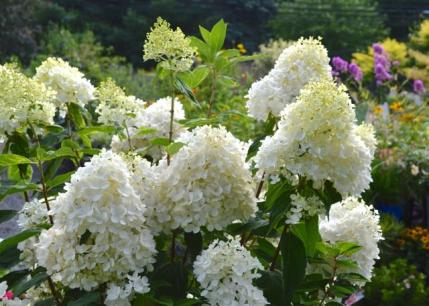
Panicle Hydrangeas are so EASY to Grow!
Nancy DuBruleShare

Hydrangea paniculata is a very old-fashioned plant that has been used in our gardens for centuries. When I was first designing gardens, we simply referred to them as Pee Gees. That stood for Hydrangea paniculata 'Grandiflora', the standard tree hydrangea in the industry. This species of hydrangea is totally hardy all the way up to Vermont, USDA hardiness zones 3-7. There are NO issues with this plant not blooming as the flowers are set up on new wood each spring. Pruning is simple- cut as hard as you want every year in April. Panicle hydrangeas have white flowers and H. paniculata 'Grandiflora' turns pink as the weather cools down, in late summer into early fall. The flowers can be cut fresh and immediately place in water or, once they have turned pink, can be cut, tied together, and hung upside down in a cool, dark place and be dried for fall and winter arrangements.
Panicle hydrangeas have come a LONG way since my early days of garden designing. Now, they are available in a mind boggling array of varieties. Some are dwarf, reaching a mere 2-3 feet tall and wide. Others are early bloomers, flowering in June and going from white to red or pink in July. Some start out lime green instead of white and then turn to pink. Many have single flower panicles, with sterile flowers that attract pollinators.

Hydrangea paniculata plants can be purchased in two forms. The shrub form is a plant that has multiple stems coming up out of the pot. Some folks treat these as shrubs and cut the entire plant back very hard in early spring, keeping it short, full, and bushy. Others select out 3-5 of the strongest, upright growing stems and train them to be multi-stemmed, small trees. This is done by continuously removing the lower side branches (limbing up) until the canopy reaches the desired height. Then, the rounded top is thinned and pruned back each year. Occasional replacement trunks are allowed to grow up to keep the plant vigorous. The second form is called a "standard" or tree form. Think of a lollipop and you will get the picture. These are grown for many years at the nursery by selecting a single, strong, upright trunk, growing it up a stake until it reaches the desired height, then topping it to make it branch. After that, the top is pruned continuously until the crown reaches a saleable size. Tree form hydrangeas cost more money because of the extra time and labor needed to produce them. They are sold staked and, once planted, a thick, sturdy, tall oak stake should be added and the trunk should be tied in multiple places. Always tie TO THE STAKE and then loosely loop around the trunk so the tree can move in the wind.
Do panicle hydrangeas come in blue? NO. Can you change the color of their flowers by changing the acidity of the soil? NO. White, pink, deep rose, red, and lime green are their color palette. Do panicle hydrangeas need full sun? No. They will grow just fine in partial shade. Deep shade isn't good as they will become week and not have many flowers. Can panicle hydrangeas be planted in wet soil? No. All hydrangeas need moisture in the soil in dry spells, but soggy soil that holds water for long periods of time will not work. Do panicle hydrangeas get a lot of insect and disease pests? No. Their biggest pest are deer. If you train the canopy up high enough you will eventually eliminate that problem! But panicle hydrangeas kept as low shrubs are just as susceptible to deer browse as all the other species.
Here are a few of the most popular, newer varieties to showcase the wide diversity available.
Hydrangea paniculata 'Limelight'- (shown below) Large panicle flowers open a soft lime green in August, fading to soft pink in the fall. This is a much sought after, full sized tree hydrangea that will grow 6-8' tall. The fresh flowers are sought after in the floral industry.
'Little Lime' has the same flower power but grows 3-4' tall and 4-6' wide.

Hydrangea paniculata 'Vanilla Strawberry'- (shown at the top of this post) Giant, towering flowers of pure white open in late July, turning to bright pink in mid-August and finally deep strawberry pink in the cool fall weather. Grows 6-7' tall and 4-5' wide. Ideal for dried flowers, wreaths, and arrangements.
Hydrangea paniculata 'Quickfire'- This variety blooms in late June with upright, open white panicles that quickly turn to rich pink. The fall foliage is exceptional- deep maroon red and orange (shown below). Grows 6-8' tall and wide.
'Little Quickfire' has the same flowers, growing only 3-5' tall and wide.

Hydrangea paniculata 'Bobo'- (shown in the Natureworks gardens below) An excellent dwarf with large, full sized, white flowers in August that turn to pink in the fall. 3' tall, 3-5' wide.

Hydrangea paniculata 'Firelight Tidbit'- A super dwarf that starts blooming in mid-July with pure white flowers that turn pink and remain colorful for three months. Grows a mere 2-3' tall and wide.
The introduction of new varieties of panicle hydrangeas offers gardeners one of the most exciting developments in the world of horticulture. There are over 25 varieties listed by our suppliers! There is a panicle hydrangea for every landscape situation.
